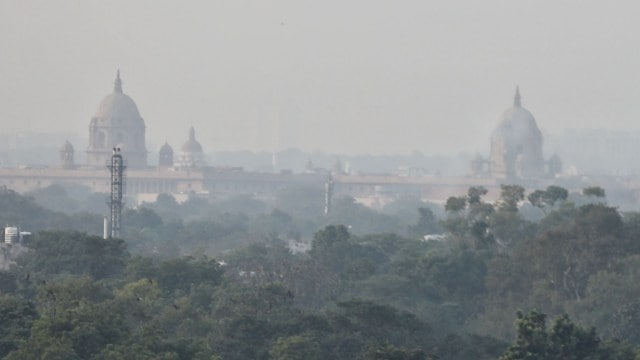Delhi ready for its first spell of artificial rain after successful trial: CM
In a four-hour operation, flares containing silver iodide and sodium chloride were fired between Khekra and Burari using the pyro method to test aircraft and equipment readiness.
 Haze engulfs the area around Raisina Hills in New Delhi on Thursday. (Abhinav Saha)
Haze engulfs the area around Raisina Hills in New Delhi on Thursday. (Abhinav Saha)Delhi is set to see its first-ever spell of artificial rain through cloud seeding between October 28 and 30, if the weather conditions permit, said Chief Minister Rekha Gupta on Thursday as the government carried out a “successful seeding trial flight”.
The proving flight, conducted jointly by IIT Kanpur and the Delhi government’s Environment department, originated from the IIT Kanpur airstrip and covered the Kanpur-Meerut-Khekra-Burari-Sadakpur-Bhojpur-Aligarh-Kanpur route, said officials.
In a four-hour operation, flares containing silver iodide and sodium chloride were fired between Khekra and Burari using the pyro method to test aircraft and equipment readiness.
The Chief Minister called the trial a “historic step” in Delhi’s fight against air pollution. “Preparations have been completed for the first time in Delhi to induce artificial rain through cloud seeding. Experts have successfully tested it in the Burari area. If (the) conditions remain favorable, Delhi will experience its first artificial rain on October 29,” she said in a post on X.
The remarks came as the Capital recorded ‘very poor’ air quality for the fourth consecutive day.
Environment Minister Manjinder Singh Sirsa said all technical trials had been completed and that Delhi was “technically ready” for its first artificial rainfall experiment. “Today’s flight was successful in every technical parameter. We have now completed all required trials including flare tests, fitment checks, and coordination protocols. The only thing we await is the arrival of suitable clouds, expected around October 29-30,” Sirsa said.
According to technical observations, the skies over Delhi remained largely clear on Thursday, with only two small cloud patches identified near Burari.
The four-hour flight tested flare deployment, aircraft endurance, and coordination between meteorological and aviation teams, officials said.
Earlier in the day, Sirsa had said that cloud seeding and initiative with the help of IIT Kanpur and the India Meteorological Department would be conducted once weather conditions were adequate.
He also outlined plans to add 70 new mechanised sweepers, 70 additional anti-smog guns, and 140 litter pickers covering 1,440 km of roads as part of the government’s broader air pollution management strategy.
With artificial rain pitched as a relief for Delhi’s air quality dipping post-Diwali, Sirsa, earlier this week, clarified that the plans to start cloud seeding cannot happen without clouds. “Cloud seeding happens only when there are clouds. First comes the ‘cloud’, then the ‘seeding’. Without clouds, cloud seeding is scientifically impossible. People should understand science before making political statements,” he had said.
The Directorate General of Civil Aviation (DGCA) has already granted permission for cloud seeding operations in Delhi between October 1 and November 30. The initiative, first planned for July, was postponed several times due to prolonged monsoon conditions.
Delhi’s air quality, meanwhile, remained in the ‘very poor’ category for the fourth consecutive day on Thursday, with the city recording an average AQI of 322, according to Central Pollution Control Board data. Departments have been asked to strengthen coordination through the Green War Room and intensify actions across 13 identified high-AQI hotspots.







